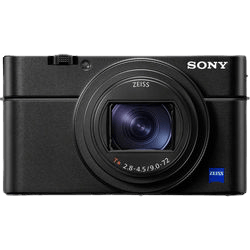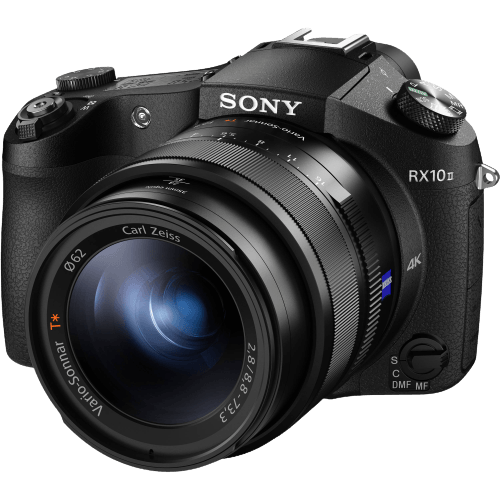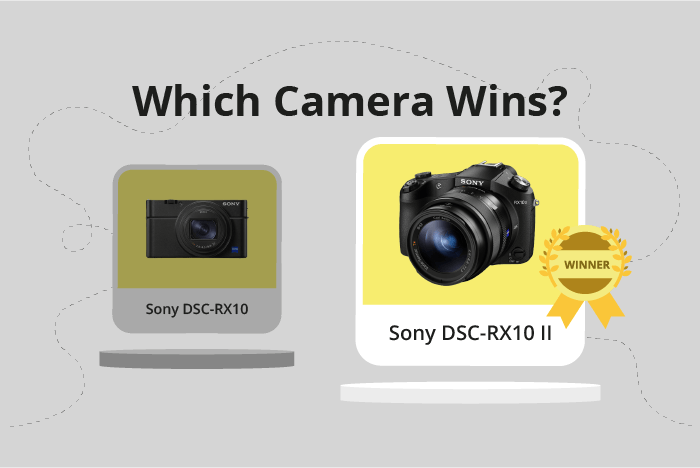Sony Cyber-shot DSC-RX10 vs Cyber-shot DSC-RX10 II Comparison
Sony Cyber-shot DSC-RX10

Sony Cyber-shot DSC-RX10 II

Among the two bridge cameras, the Sony Cyber-shot DSC-RX10 II emerges as the winner with a score of 59/100, while the Sony Cyber-shot DSC-RX10 scores 55/100. Both cameras share common specifications such as identical size (129 x 88 x 102mm) and weight (813g / 1.79lbs), as well as the same launch price of around $1299.
The DSC-RX10 II, released in 2015, outperforms its predecessor, the DSC-RX10, which was released in 2013. This improvement is evident in its higher score, making it the better choice among the two. However, the older DSC-RX10 still holds its ground as a viable option for those seeking a more budget-friendly camera.
Taking into account these specifications, the Sony Cyber-shot DSC-RX10 II proves to be the superior choice, but the Sony Cyber-shot DSC-RX10 remains a decent alternative for those not requiring the latest features.
Sony Cyber-shot DSC-RX10 vs Cyber-shot DSC-RX10 II Overview and Optics
The Sony Cyber-shot DSC-RX10 II emerges as the winner in the optics comparison, scoring 64/100, just a single point ahead of the Sony Cyber-shot DSC-RX10, which scores 63/100. Both cameras share several common specifications, including 20 megapixels, a CMOS sensor type, a Bionz X processor, a 1″ sensor size, a fixed lens mount, and image stabilization.
The DSC-RX10 II outperforms its counterpart in shooting speed and DXOMARK sensor score. It boasts a shooting speed of 14, compared to the DSC-RX10’s 10, making it more efficient in capturing fast-moving subjects. Additionally, the DSC-RX10 II’s sensor receives a DXOMARK score of 70, slightly higher than the DSC-RX10’s score of 69, which contributes to better image quality.
Although the DSC-RX10 falls short in shooting speed and DXOMARK sensor score, it still offers high-quality optics, sharing many specifications with the winning camera. The difference in performance is minimal, and users can still expect excellent results from the DSC-RX10.
Considering the optics comparison, the Sony Cyber-shot DSC-RX10 II stands out as the superior choice due to its faster shooting speed and marginally higher DXOMARK sensor score. However, the Sony Cyber-shot DSC-RX10 remains a strong contender, offering nearly identical specifications and performance. Ultimately, users should weigh their priorities and preferences when choosing between these two cameras, as both provide impressive optics capabilities.
Sony Cyber-shot DSC-RX10 vs Cyber-shot DSC-RX10 II Video Performance
The Sony Cyber-shot DSC-RX10 II outperforms the Sony Cyber-shot DSC-RX10 in video capabilities, with a video score of 77/100 compared to the DSC-RX10’s 56/100. Both cameras share some common specifications, such as lacking built-in time-lapse functionality. However, the DSC-RX10 II surpasses its predecessor in several aspects.
The most significant improvement in the DSC-RX10 II is its maximum video resolution, which is 4K (3840 x 2160), while the DSC-RX10 only offers Full HD (1920 x 1080). This means that the DSC-RX10 II can capture videos with much higher detail and clarity than the DSC-RX10. Additionally, the DSC-RX10 II has a maximum video frame rate of 120fps, doubling the DSC-RX10’s 60fps. This allows for smoother video playback and better slow-motion effects in the DSC-RX10 II.
On the other hand, the DSC-RX10 does not have any notable advantages over the DSC-RX10 II in terms of video capabilities. Its lower video score reflects its inferior performance in this area.
Taking these points into account, it is evident that the Sony Cyber-shot DSC-RX10 II is a superior choice for those who prioritize video quality and functionality. The higher video score, 4K resolution, and increased frame rate make it a clear winner in comparison to the Sony Cyber-shot DSC-RX10.
Sony Cyber-shot DSC-RX10 vs Cyber-shot DSC-RX10 II Features and Benefits
The Sony Cyber-shot DSC-RX10 II emerges as the winner in the features comparison, scoring 57 out of 100, while the Sony Cyber-shot DSC-RX10 scores 44 out of 100. Both cameras share several common specifications, making them closely related in terms of features.
Both the RX10 and RX10 II have a 3-inch screen size and a screen resolution of 1,228,800 dots. Neither camera offers a touchscreen or flip screen feature. Additionally, both models do not have GPS but come equipped with WIFI capabilities.
The RX10 II outperforms its predecessor in one key area: it has Bluetooth connectivity. This additional feature enables users to easily connect the camera to other devices, such as smartphones and tablets, for seamless sharing of images and videos. This added convenience makes the RX10 II a more appealing choice for those who value easy connectivity and sharing options.
On the other hand, the RX10 does not offer any notable advantages over the RX10 II. Its lower feature score reflects a lack of improvements compared to the newer model. The RX10 II’s higher score signifies that it is a better camera in terms of features.
Considering the differences between the two models, the Sony Cyber-shot DSC-RX10 II stands out as the better choice due to its Bluetooth connectivity. The RX10, although still a capable camera, falls short in comparison to its successor. Therefore, potential buyers should opt for the RX10 II for a more feature-rich and convenient photography experience.
Sony Cyber-shot DSC-RX10 vs Cyber-shot DSC-RX10 II Storage and Battery
The Sony Cyber-shot DSC-RX10 and the Sony Cyber-shot DSC-RX10 II both have a storage and battery score of 24/100. They share several specifications, such as having only one memory card slot and accepting SD / SDHC / SDXC, Memory Stick Duo / Pro Duo / Pro-HG Duo memory cards. Both cameras also use the same battery type, NP-FW50, and do not have USB charging capabilities.
The DSC-RX10 has a slight advantage in battery life, providing 420 shots compared to the DSC-RX10 II’s 400 shots. However, the DSC-RX10 II does not have any advantages over the DSC-RX10 in terms of storage and battery.
Considering the storage and battery aspects, the Sony Cyber-shot DSC-RX10 offers a marginally better battery life, while the two cameras are otherwise equal in this category.
Sony Cyber-shot DSC-RX10 vs Cyber-shot DSC-RX10 II – Our Verdict
Are you still undecided about which camera is right for you? Have a look at these popular comparisons that feature the Sony Cyber-shot DSC-RX10 or the Sony Cyber-shot DSC-RX10 II:

